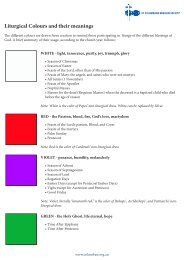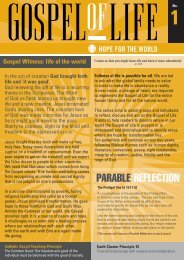2013 Columban Calendar - Art Guide - St Columbans Mission Society
2013 Columban Calendar - Art Guide - St Columbans Mission Society
2013 Columban Calendar - Art Guide - St Columbans Mission Society
You also want an ePaper? Increase the reach of your titles
YUMPU automatically turns print PDFs into web optimized ePapers that Google loves.
<strong>Columban</strong> <strong>Art</strong> <strong>Calendar</strong><br />
<strong>2013</strong><br />
<strong>2013</strong><br />
<strong>Art</strong> <strong>Guide</strong>
<strong>Columban</strong> <strong>Art</strong> <strong>Calendar</strong><br />
<strong>2013</strong>
Front Cover<br />
Madonna and Saints Adoring the Child (detail),<br />
Perugino (1445/50-1523)<br />
Throughout the Middle Ages and Renaissance the great mystery of<br />
Christ’s taking on of human flesh, of His becoming one with humanity,<br />
found full expression in the figure of His mother Mary. Why did<br />
theologians, poets, mystics and of course artists look to the story of a<br />
poor young woman’s improbable encounter with the divine? Why did<br />
they find in the story of the Virgin birth an account of love, generosity<br />
and wisdom that continues to inspire and challenge us to-day? Like a<br />
window admitting light on a profound secret, this detail of the Virgin in<br />
prayer from Perugino’s painting of The Virgin Adoring the Child with<br />
Two Saints, hints at some of the reasons why the Virgin, the Mother of<br />
God, remains a “portal to the divine.” This Umbrian master, the teacher<br />
of the “divine” Raphael, presents a woman of flesh, composure, and<br />
intelligence, in short, a woman absorbed in contemplation of her child<br />
the God-Man. Never has the quest to lose oneself in God appeared so<br />
completely human and totally natural. This woman reminds us of our<br />
share in the divine gift of life in Christ.
January <strong>2013</strong><br />
The Sacrament of Extreme Unction,<br />
Nicholas Poussin (1594-1665)<br />
Nicholas Poussin is depicting of the administering of the final<br />
sacrament which we to-day know as the Sacrament of Healing. He<br />
locates the scene in a setting remote both from us to-day and from<br />
the original seventeenth-century audience for this work. The painting<br />
comes from Poussin’s cycle of The Seven Sacraments, which he painted<br />
between 1637 and 1642 for a distinguished Roman patron, Cassiano del<br />
Pozzo. The clarity, balance and reverence for classical tradition which<br />
this painting exudes soon led to a commission for a second series on the<br />
same subject. Poussin invests the scene of mourning with dignity. At<br />
the centre of the painting the figure of the dying man stretched out on<br />
the bed creates a strong horizontal accent. He is surrounded by figures<br />
whose actions and facial expressions convey the contradictory emotions<br />
of grief at the loss and hope in the efficacy of the sacrament. Despite the<br />
references to a distant past in the classically inspired architecture and<br />
costume, the timeless power of the Christ’s presence in the sacrament is<br />
evoked through symbols. Light, oil and prayer, symbols of healing and<br />
new life in Christ then as now, reassure us of the presence of God in our<br />
world through all time.
February <strong>2013</strong><br />
The Presentation in the Temple,<br />
Lorenzo Monaco (c. 1370-1425)<br />
The size and shape of this small panel indicate that this painting<br />
originally formed part of the predella (the lower horizontal section) of<br />
an altarpiece. Traditionally this lower area of an altarpiece depicted<br />
stories from the lives of the saints who were pictured above. This scene<br />
shows Christ’s presentation in the Temple. Alongside the Nativity and<br />
other scenes from Christ’s Infancy, this moment which we read of in<br />
Luke 2:22-39 was frequently represented in the early Renaissance.<br />
Lorenzo Monaco situates the scene outdoors, in front of the high<br />
temple, which he evokes in the church-like building at the right. Mary<br />
stands prominently in the foreground, her blue-clad robe distinguishing<br />
her from others around her in their paler colours. Christ’s mother<br />
steps away from the other figures as she hands the Child to Simeon<br />
the High Priest of the Temple. The consecration of a first-born child<br />
was an important ritual of Jewish religious life. The interaction at the<br />
centre of the panel between the Virgin, Christ and Simeon enhances the<br />
solemnity of this action. So does the response of Anna the prophetess,<br />
who appears clad in pale green just to the left of the Virgin. The scroll<br />
which unfurls from Anna’s left hand reminds us how she spoke to all<br />
“who were looking for the redemption of Jerusalem.”
March <strong>2013</strong><br />
Crucifixion Diptych,<br />
Roger van der Weyden (c. 1399-1464)<br />
Roger van der Weyden’s stark depiction of The Crucifixion forces the<br />
viewer to engage with the pathos of suffering. Two individual panels<br />
framed into a diptych portray the Crucifixion not as an historical scene<br />
but as an event that appears in a timeless devotional context. We lack<br />
the familiar narrative cues such as the hill of Golgotha, the two thieves<br />
or those standing at the base of the cross. Instead Roger emphasizes the<br />
intensity of the reactions of <strong>St</strong> John the Evangelist and Christ’s grieving<br />
mother. John leans forward to catch the Virgin as she collapses. Her<br />
eyes remain closed as if she can no longer bear the sight of the suffering<br />
her son must endure. The frame between the two panels separates the<br />
mother from her child. Roger uses this division to suggest a deeper<br />
spiritual bond which unites the desolate scenes. Both Mary’s head and<br />
Christ’s head fall downward like mirror images. It is as if this gentle<br />
bodily motion symbolizes the ineradicable union of mother and Son.<br />
The separation of the panels remind us that although we may be distant<br />
from the historical reality of Christ’s passion we, like the Virgin and<br />
the original viewer of this painting, can draw close to Christ when we<br />
identify with the suffering of all humanity.
April <strong>2013</strong><br />
Annunciate Virgin,<br />
Leonardo da Vinci (1452-1519)<br />
The theme of the Annunciation in Christian art has a rich tradition.<br />
<strong>Art</strong>ists employed a variety of symbols to evoke the mystery of Mary’s<br />
acceptance of God’s invitation to become the Mother of God. Leonardo<br />
reveals the Virgin momentarily interrupted during her reading. She<br />
registers the angel’s presence in her gesture of greeting. The astounding<br />
message that the angel delivers seems not to disturb an atmosphere<br />
of calm serenity. Indeed the Virgin’s fingers have not moved from the<br />
place in the text that marks the passage she was reading. Tradition<br />
taught that Mary was reading the prophet Isaiah : “Behold a Virgin shall<br />
conceive and bear a child.” Leonardo bathes the figure of the Virgin and<br />
her surroundings in a light that caresses equally skin, stone, plant-life<br />
and distant mountain. All creation is enveloped in the stopped moment<br />
of God’s in-breaking presence amongst us.
May <strong>2013</strong><br />
Visitation,<br />
Domenico Ghirlandaio (1448-1494)<br />
The feast of the Visitation commemorates the event about which we<br />
read in Luke1: 36-56. We learn there how two women in equally<br />
mysterious and miraculous ways have become pregnant. Mary the<br />
younger woman travels to visit her much older cousin Elizabeth, who<br />
lives with her husband Zacharia in the city of Judah. Ghirlandaio<br />
recreates the moment when the two women greet each other,<br />
presumably after a long absence. The profound joy that each woman<br />
experiences from the new life expanding inside her finds expression in<br />
a central image: the women’s act of embracing. In contrast to the social<br />
conventions of the time, it is Elizabeth, the older woman, who kneels in<br />
reverence and respect before her much younger cousin. Elizabeth’s pose<br />
of homage perhaps also anticipates visually, the great song that Mary is<br />
about to proclaim, the Magnificat. This hymn exalts the Lord who raises<br />
up the most lowly such as Mary herself and gives comfort to those who<br />
are hungry and despised. Ghirlandaio is evoking the up-ending of the<br />
social order through casting down of the the mighty and of the natural<br />
order through conception by a Virgin. The artist reminds us that like the<br />
bonds of love and empathy which unite Mary and Elizabeth God’s love<br />
will endure and sustain the two mothers and us.
June <strong>2013</strong><br />
The Raising of Lazarus,<br />
Luca di Tommé (1330-c. 1389)<br />
Born in Siena in 1330, Luca di Tommé inherited the artistic tradition of<br />
his great predecessor, Duccio. Luca’s interpretation of the story found<br />
in John’s gospel of the Raising of Lazarus follows faithfully Duccio’s<br />
earlier composition. Luca borrows features such as the rocky setting,<br />
the grouping of Christ and the disciples at the left of the panel. These<br />
figures stand directly opposite Lazarus, who appears at the entrance<br />
of the rock-cut vertical tomb. As Christ and Lazarus face each other<br />
across space, the drama of their interaction is mirrored in the reaction of<br />
the crowd. The disciples turn toward each other, their faces registering<br />
their shock and awe. Others in the crowd strain to get a better view of<br />
the scene, while the man standing next to the tomb holds his hand to<br />
his nose. This act of revulsion graphically conveys the earthy drama of<br />
this miracle. In a commanding gesture Christ’s right arm extends across<br />
the center of the space. This divine action acquires further authority<br />
through the words which would once have been clearly visible. Moving<br />
in a direct line from Christ’s mouth to Lazarus, the Latin text reads -<br />
“LAZARE VENI FORAS” – “Lazarus, come forth.” At the beginning<br />
of John’s gospel we hear of the word becoming flesh. Here Luca<br />
reminds us of the gift which God made to Creation through the person<br />
of Jesus. He shares our flesh and gives freely his gift of divine life.
July <strong>2013</strong><br />
Madonna and Saints Adoring the Child,<br />
Perugino (1445/50-1523)<br />
Perugino, the teacher of Raphael, is celebrated for his paintings of the<br />
Virgin. This detail from a small devotional panel now in the Pierpont<br />
Morgan Library in New York evokes a mood of gentle contemplation.<br />
The two saints kneeling on either side of the Virgin reinforce the<br />
atmosphere of prayer. Nothing in the scene distracts them (or the<br />
viewer) from the focus of the figures’ devotion, which of course we<br />
must imagine. Perugino swathes his figures in garments whose weight<br />
and gently falling folds convey a vivid physical presence. A soft<br />
atmospheric light binds the foreground figures to the landscape in the<br />
distance and persuades us visually of a deeper unity which unites us<br />
with the Virgin and Saints before us. What hopes and what fears do we,<br />
like them, bring to the Christ child? Of course, because here we see<br />
only a detail of the larger painting, we must rely on our imagination to<br />
complete the scene. Sometimes even a partial glimpse of the sacred can<br />
be enough to nurture us on our journey.
August <strong>2013</strong><br />
Assumption of the Virgin,<br />
Fra Angelico (1387-1455)<br />
Throughout the Middle Ages and Renaissance, the status of Mary<br />
as mother of God found expression in the lives of everyday women<br />
and men. Paintings in churches, people’s homes and public buildings<br />
often included an image of the Virgin. How was people’s faith shaped<br />
by these paintings? Fra Angelico’s depiction of the Assumption of<br />
the Virgin comprises this central scene as part of a larger panel. The<br />
Dominican friar painter celebrates the moment when the Virgin passes<br />
from earthly life to her heavenly home. To do so he deploys a gorgeous<br />
coloristic display of the most exquisite shades of blue, red and green.<br />
Mary stands full-length encircled by angels, her form radiating light.<br />
Meanwhile, the hues of the garments worn by those angels further from<br />
the Virgin appear more saturated in luminous colour. This dispersion<br />
of colour from centre to periphery evokes symbolically the mystery of<br />
redemption as it radiates throughout the world. Like the love that issues<br />
forth from Christ to transform all creation, Mary emits a force-field of<br />
love of such intensity that it cannot be contained. Light emanating from<br />
Mary passes through a painterly metamorphosis into dazzling colour.<br />
The light radiating from her garment seems to suffuse the entire space,<br />
just as God’s love suffuses this world. The beauteous pigments of this<br />
painting make the Virgin live for us through a theology transmuted into<br />
colour.
September <strong>2013</strong><br />
The Return of the Prodigal Son,<br />
Guercino (1591-1666)<br />
The Bolognese artist Guercino captures the drama of the reconciliation<br />
between father and son in his version of the parable of the Return of<br />
the Prodigal Son. With gentleness, the father draws his remorseful son<br />
towards him. His embrace signals the father’s love and concern for this<br />
wayward son. Note how Guercino contrasts the young man’s torn and<br />
tattered shirt with the rich fabric of the father’s tunic and cloak. The<br />
contrast underlines how far the son had fallen from a life of wealth and<br />
privilege. Guercino hints at the vulnerability of the young man. His<br />
exposed left arm and chest remind us of the hardships he has endured;<br />
even the pigs he tended received better treatment than him. Meanwhile<br />
in the background, the presence of another figure whom we identify as<br />
the older brother reminds us of the disgruntled son’s role in the parable.<br />
With hands clasped as if to suggest his inner turmoil at the return of<br />
his younger brother, Guercino manifests the “good” son’s anguish<br />
and resentment. As this parable teaches, God’s love and forgiveness<br />
know no bounds or conditions. It embraces both sons and us. Like the<br />
depiction of the rejoicing father in this painting, such love is generous,<br />
gentle and never reproachful.
October <strong>2013</strong><br />
Christ and the Samaritan Woman,<br />
Duccio di Buoninsegna (c. 1260-1318)<br />
The panel by the great medieval Sienese master, Duccio, leads us into<br />
a devotional and cultural world where the influence of Byzantine art<br />
had continued to hold sway in Europe, especially in Italy. Sienese artists<br />
admired and sought to replicate the elegance, technical precision and<br />
glowing colours typical of Byzantine art. Like many other Sienese<br />
artists, Duccio sought above all to imbue traditional subjects like Christ<br />
and the Samaritan Woman with a haunting beauty that derived from<br />
Byzantine art. In this painting Duccio depicts the encounter between<br />
Christ and the unnamed woman with simplicity and solemnity. Christ<br />
appears seated on a fine marble well. The woman who stands opposite<br />
him engages directly with Christ in conversation. Duccio suggests the<br />
intimacy and respectfulness of this encounter between two people, who<br />
in that society have no business speaking together. Both Christ and the<br />
woman stand a little apart from each other. Note, however, how after<br />
the man and the woman have established contact through shared glances<br />
and gestures this action appears to collapse the physical (and temporal?)<br />
space which separates not only Christ and the woman from one another<br />
but also separates us from this moment. We observe that the woman<br />
carries a jar on her head as well as a metal pot which was used to draw<br />
water from the well. It is unclear which moment of the meeting Duccio<br />
has portrayed. Has the woman just arrived or is she about to return to<br />
her village to spread the news of her life-changing encounter? Duccio<br />
gives us a clue in the detail of the apostles, who are depicted returning<br />
with food at the right of the scene. The figures in the front hold loaves<br />
of bread in their cloaks. The disciples return with food for the body; the<br />
woman leaves with the gift of eternal life.
November <strong>2013</strong><br />
The Last Judgement detail: Enrico Scrovegni<br />
presenting the Scrovegni Chapel,<br />
Giotto (1266-1336)<br />
This detail from the west wall of the Scrovegni Chapel, Padua, recalls<br />
for us how heavily the weight of family honour and shame influenced<br />
late medieval life. Those who like tyrants, unscrupulous merchants<br />
and money-lenders abused their wealth and power, often became the<br />
target of fierce criticism. Enrico Scrovegni’s father Reginaldo was<br />
denounced by Dante for his sharp practices as money-lender. The<br />
public nature of his family’s offence could only be off-set by an equally<br />
public gesture of contrition. Hence Enrico decided to erect the chapel<br />
that bears his name. In this small simple space Giotto created one of<br />
the most astonishing ensembles in the entire history of art, one that has<br />
enjoyed unreserved praise from every sort of viewer. Traditionally the<br />
scene of the Last Judgement was placed on the inner west wall of a<br />
church, so that as the faithful exited they would be reminded of the<br />
Judgement awaiting them. Here the viewer looked up to see the patron<br />
Enrico Scrovegni presenting to three saints a model of the chapel that<br />
he has built and paid for. The central haloed figure is usually identified<br />
as the Virgin, and indeed the chapel was dedicated to her. In loving<br />
kindness she stretches out her right hand in a movement which conveys<br />
her acceptance of the penitent donor’s tribute to her honour. The<br />
Virgin’s loving, expansive gesture echoes across seven centuries as new<br />
generations of viewers contemplate the promise of redemption.
December <strong>2013</strong><br />
Adoration of the Baby,<br />
Gerrit van Honthorst (1590-1656)<br />
Many artists have explored scenes from Christ’s life against the<br />
dramatic backdrop of night. This Flemish artist’s depiction of the scene<br />
of the Adoration of the Baby invites us too to draw near to the tiny<br />
child, who lies vulnerable before us. We too join the intimate circle<br />
of adorers - Mary, Joseph and the two angels – who kneel before the<br />
Child’s make-shift cradle. Honthorst was renowned for his night scenes.<br />
His explorations of the way light could be manipulated both to highlight<br />
and to conceal action and emotions seem to culminate in the mood of<br />
reverence that he evokes in this painting. Both for Honthorst’s original<br />
viewers and for us, the radiant light of Christ bathes the entire space<br />
and illuminates with joy the faces of the beholders. The darkness in the<br />
background emphasizes the glory of the light. Just as light triumphs<br />
over darkness in this painting, so God’s gift of Jesus urges us to nurture<br />
this fragile yet brilliant light, the source of our love and life. We all pray<br />
that the Christmas Season will spread God’s light throughout the world<br />
in just the way that the light of the infant Jesus illuminates this painting.<br />
The Christmas promise shines out from this image.
PO Box 752, Niddrie, Vic, 3042<br />
Phone: (03) 9375 9475 Fax: (03) 9379 6040<br />
Email: calendar@columban.org.au<br />
www.columban.org.au/<strong>2013</strong>artguide
















